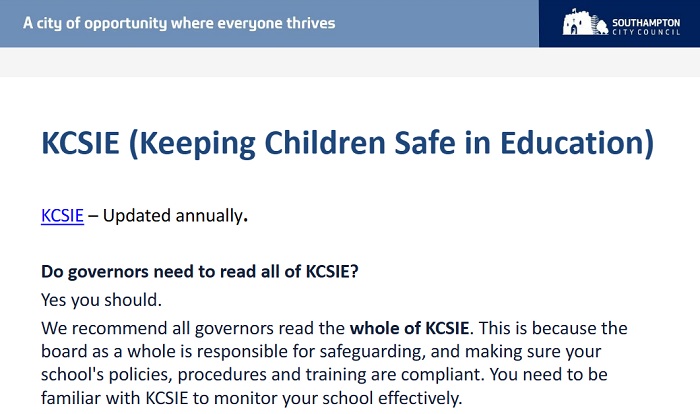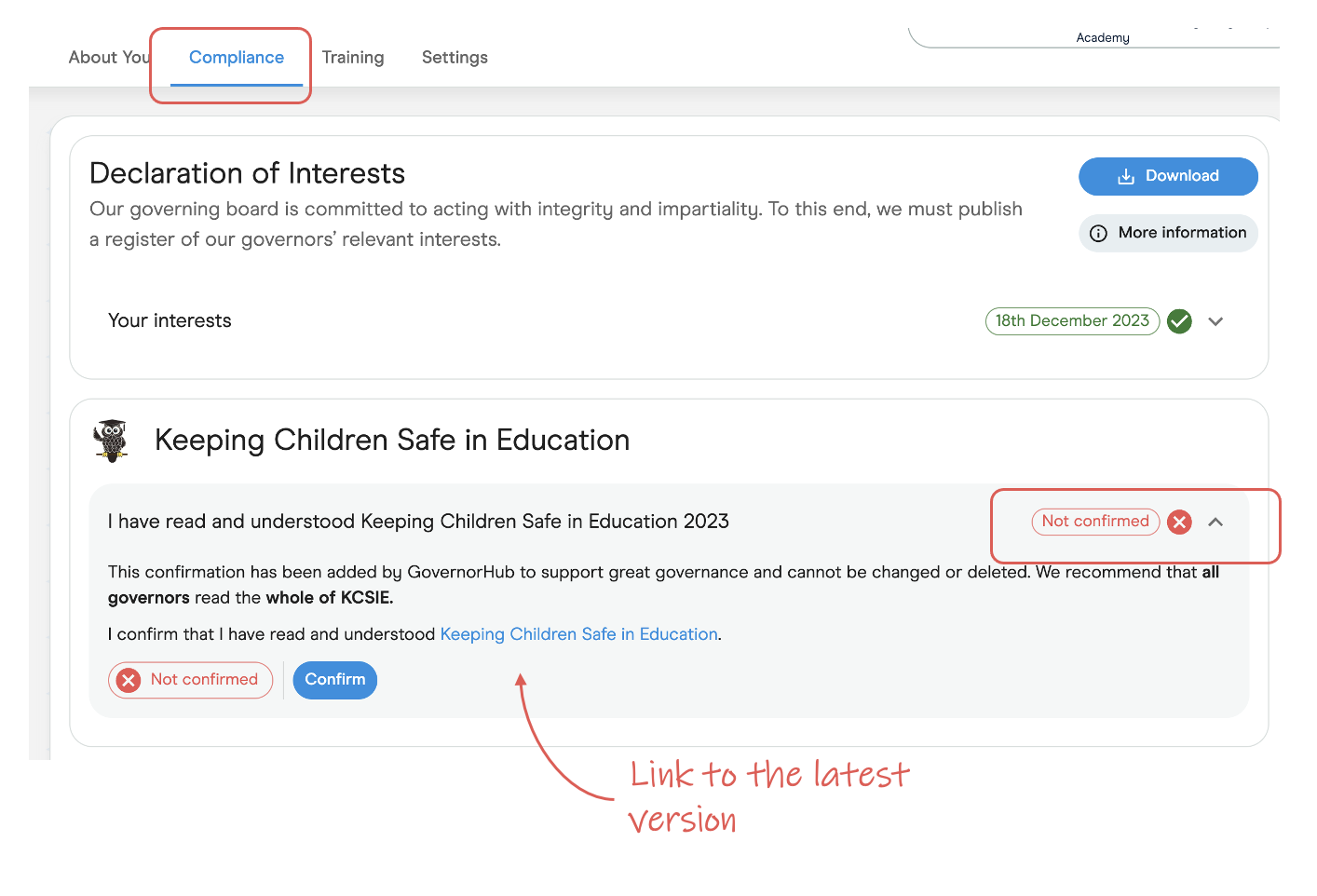The DfE Governance Guides published in March 2024 recommend that the following people read part two of Keeping Children Safe in Education (KCSIE):
- governors and associate members in maintained schools
- trustees and local governors in academies
- clerks/governance professionals.
However, the Governance Guides also make it clear that governing bodies must comply with the safeguarding duties they have in law and ensure that child protection policies, procedures and training are in place and effective.
Boards are only going to be aware of all their safeguarding duties if at least one governor reads the whole of KCSIE.
(The quote below is from the Maintained Schools Governance Guide but the wording is almost exactly the same in the Academy Trust Governance Guide.)
“Governing bodies have a strategic leadership responsibility for its school’s safeguarding arrangements.
“They must:
DfE Maintained School Governance Guide
- comply with their duties under legislation
- have regard to KCSIE guidance
- ensure that policies, procedures and training in their schools are effective and comply with the law at all times.”

The safeguarding team at my local authority recommend that governors read all of Keeping Children Safe in Education (KCSIE), not just certain parts of it.
My LA’s advice is based on the fact that the entire governing body is responsible for safeguarding and making sure the school policies, procedures and training are all compliant with DfE guidance. Governors therefore need to know what is in KCSIE to monitor safeguarding effectively.

This tallies with the fact that safeguarding training is mandatory for all maintained school governors and academy trustees.
What is Keeping Children Safe in Education?
Keeping Children Safe in Education is the DfE’s statutory guidance on safeguarding. It explains how to protect children from harm, including physical or emotional abuse, bullying, neglect and online dangers.
KCSIE says that all school employees who work directly with children must read at least part one.
School employees who don’t work directly with children must read either part one or a short summary of part one which is printed in an annexe.
Why do some schools say governors only need to read part one of KCSIE?
Because some staff don’t have to read the whole guidance a myth has grown that part one is the really vital part. Therefore some schools tell both staff and governors that they only need to read part one.
It’s a strange myth, though, because it makes no sense! Part two of KCSIE describes the responsibilities of governing bodies. Who exactly is supposed to read that bit if not governors?
What does KCSIE itself recommend?
The introduction to Keeping Children Safe in Education explains that it should be “read and followed” by:
- governing bodies of maintained schools
- trust boards in academies (it calls the board of trustees the “proprietor” of the academy)
- management committees of pupil referral units, and
- senior leadership teams (the headteacher, deputy head, etc).
“Who is this guidance for?
This statutory guidance should be read and followed by:
– governing bodies of maintained schools (including maintained nursery schools) and colleges;
– proprietors of independent schools (including academies, free schools and alternative provision academies) and non-maintained special schools. In the case of academies, free schools and alternative provision academies, the proprietor will be the academy trust;
– management committees of pupil referral units (PRUs); and
– senior leadership teams.”
Keeping Children Safe in Education
So KCSIE tells us it should be “read and followed” by governing boards in both maintained schools and academies. It does not say that governors and trustees only need to read certain parts of this document.
What if governors refuse to read all of KCSIE?
Governors are volunteers and in reality some governors may not read the whole document.
The board could decide to make it mandatory if it wishes; safeguarding training is after all mandatory for all governors and trustees. The board could suspend or remove governors who refuse to read it.
Alternatively the board could set a minimum reading requirement of part two (as recommended by the Governance Guides) and then share out the other parts according to governor roles. In this way at least the board as a whole has knowledge of the entirety of KCSIE.
So part three (safer recruitment) could be assigned to governors who take safer recruitment training.
Part four (allegations again adults) could be given to the governors who will sit on disciplinary panels. It could also be read by the chair as they will usually deal with allegations against the head.
Part five (sexual violence and harassment) could be given to the safeguarding link governor.
The guidance is updated every year so the clerk can also help by highlighting any changes to the board annually.
Do governors need to sign a form to say they have read KCSIE?
It’s not a requirement for governors to sign a document declaring they have read KCSIE, but it is common practice in many schools. Check your safeguarding policy as it may say staff and governors must sign a declaration.
A signed form may prove useful if you have a safeguarding audit or OFSTED inspection. It can also indicate to governors just how important this document is.
GovernorHub is the easiest way for governors to sign a declaration. Ask governors to log in and look for the declarations tab in their profile and then the confirmations option, where they can click a button to confirm they have read and understood KCSIE. The clerk can download a list of declarations received.
Note that GovernorHub recommends that all governors read the whole of KCSIE, not just certain parts of it!

Five Parts of KCSIE
KCSIE is split into five parts. I’ve had a quick look at each part to see the relevance for governors.
Part One: Safeguarding Information For All Staff
Part one is an overview of risks including abuse, violence, mental health problems and exploitation. It explains how staff should react if they have concerns, how they can escalate concerns about poor practice and what support the LA can offer.
Part Two: The Management of Safeguarding
Part two’s subtitle is “The responsibilities of governing bodies, proprietors and management committees”. It is therefore aimed directly at governing bodies.
(A “proprietor” means an academy trust board and a “management committee” means the governing body in a pupil referral unit.)
Part two lists many requirements for governors. For example, it says governing bodies should appoint a safeguarding link governor, ensure all staff have appropriate safeguarding training and approve an effective safeguarding policy.
Part Three: Safer Recruitment
Part three of KCSIE explains the principles of safer recruitment, which means the procedures schools use to make sure they only hire staff who are suitable to work with children. This includes disclosure and barring service checks and requesting references.
Part Four: Allegations Made Against/Concerns Raised In Relation to Teachers, Other Staff, Volunteers and Contractors
Part four of KCSIE looks at handling allegations that an adult has harmed a child. The DfE Governance Guides say that all schools and academies must have procedures for dealing with allegations of abuse against staff.
Part Five: Child On Child Sexual Violence and Sexual Harassment
Part five of KCSIE explains how children can be kept safe from harm caused by the sexual comments or actions of other children.
In 2021 OFSTED conducted a review of sexual abuse in schools and colleges. The inspectors said: “It is important that governors have a good understanding of sexual harassment and sexual violence, including online, so that they can provide the right level of support and challenge for school leaders and designated safeguarding leads.”
